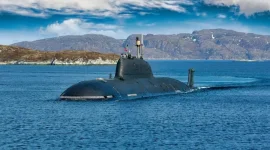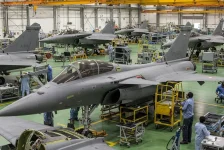- Views: 2K
- Replies: 18
Operating with just 31 fighter squadrons, against the originally sanctioned fleet strength of 42, the IAF faces a major quantitative gap in fighter jets Vis-a-vis it's hostile neighbors & arch rivals, namely, China & Pakistan. Further, China is even leading qualitatively with a clear overmatch over India in air power; having developed two 5th gen stealth fighters, in form of the J-20 and the J-35, while also currently testing a futuristic J-36 6th gen bomber. Pakistan, on the contrary, is procuring the J-35s from China while also collaborating with Turkey on the Kaan 5th gen fighter program, which is going to ensure that Pakistan will have an in-service 5th gen fighter before the end of the current decade.
India, in response, is banking on its indigenous AMCA program to counter them in a dangerous neighborhood, soon- to-be dominated by 5th gen fighter capability. However, with the earliest EIS timeline of 2035, the AMCA is going to be at least half-a-decade behind its immediate requirement. The most obvious solution to India's urgent & truly pressing need for a 5th gen capability seems to be to import a couple of squadrons of either the F-35 or the Su-57, while the AMCA is developed. However, another less explored, out of the box option which is available on the table for India, instead, is to lease a couple of squadrons of the F-35/Su-57, at least for a decade, till the AMCAs are produced & inducted by the IAF in sufficient numbers. Let’s explore the prospects of that less explored option here.
Leasing of defense equipment, especially of fighter jets, is a common practice globally with many nations having exercised the option in the past. For instance, Czech Republic leased 12 JAS-39 Gripen fighters for a decade from Saab in 2005, with the deal extended for another 12 years in 2015 and has now, in 2025, been extended further until 2035, till the ordered F-35s are delivered to it by the U.S., with the Czechs doling out $790 million for the extension, including, maintenance & pilot training. That way, the Czechs have effectively bypassed the burden of a interim fighter procurement and are moving straightaway to a 5th gen fighter capability, amid a rapidly deteriorating security environment in Europe, with the resurgence of Russian military threat.
As far as leasing of defense equipment, as an option, is concerned, India has a history of having leased the Russian military hardware, most noticeably, the $3 billion lease deal signed by India for the Akula-class nuclear submarine signed in 2019 (with the delivery scheduled for 2028) being at the top of that list. India is currently exploring the option of leasing another Akula class SSN offered by Russia and even leased a pair of American MQ-9B Reaper drones before placing the order to buy 31 of them for the IAF and the Indian Navy last year in a $3.5 billion deal.
India, thus, in a similar manner, could lease a couple of squadrons of a 5th gen fighter for the interim, at least for a decade, with F-35 and Su-57 being the most logical options, to effectively deter China and Pakistan before the AMCA goes online & becomes available to the IAF.
Let’s explore the Pros and Cons of that option:-
Pros
1. The move could save India a substantial amount of money required to foot the burden of importing a 5th gen fighter for the interim. The saved sum saved could be effectively used judiciously elsewhere while also effectively being able to deter China & Pakistan.2. Bridge the relative & rapidly widening 5th gen capability gap with China in the most optimum & least risk manner without committing to an imported 5th gen platform for the long term while psychologically also not leaving the IAF devoid of a 5th gen fighter for a prolonged period of a decade.
3. Provide IAF pilots & maintainers with the invaluable experience of operating and maintaining a 5th gen fighter platform; especially with the development of pilot training, aircraft deployment plans as well as a usage doctrine based on the jet’s capabilities; while also addressing the maintenance part of stealth coatings etc. which would be invaluable for the AMCA later. Same as buying and locally producing them.
4. A potential decision to procure the Su-57 under lease could further strengthen the already strong India-Russia strategic ties without taking India further deeper into the Russian orbit for the long term.
5. A decision to go for the F-35, on the contrary, could further strengthen India-America ties while also placating Trump on the trade war front and also offset his rhetoric & criticism on India’s arms export and oil deals from Russia.
6. A lease deal with Russia for the Su-57, unlike buy, is also likely to keep Trump and the U.S. at ease geopolitically; while securing India's overall strategic interests and also being in alignment with India's strategic autonomy in foreign policy and 'Make in India' policies for defense; given the credibility of the two-front China-Pakistan threat to India duly acknowledged by the U.S.
7. A lease deal Is likely to give a huge fillip to India’s Make-in-India program for defense by showcasing India’s deep & unwavering commitment to it while ensuring & addressing national security interests simultaneously.
8. Will save India the burden of investing substantially towards setting up a local industrial base for local production under license (especially for the F-35) and to establish a local MRO facility to maintain the jets, and also create supply chain for spares, through the long lifespan of 4 decades for fighter jets.
9. The limited (lack of all-aspect) stealth capabilities of the Su-57, with a relatively higher radar cross section than the F-35, would not be a huge concern, if the Su-57 is selected, as India would only be leasing it just for a decade or so rather than committing to it forever.
10. The lease deal would give India a lot of flexibility by even providing the option to extend the deal, in case the AMCA gets delayed, or to even retain the jets after the original lease tenure is over by paying the required sum.
Cons
1. The lease deal, unlike buying, would impair India’s ability to get the source code from the manufacturer which would impact India’s ability to customize the jets for the long term with domestically manufactured avionics, missiles and armaments.2. The U.S., most likely, is unlikely to agree to leasing the F-35 to India or manufacture it locally (even under buy) owing to the sensitive nature of technologies onboard the jets and India’s usage of S-400 air defense system as it could compromise the technological edge of the F-35 against the Russian system. The refusal of the U.S. would automatically lead to obviation of any potential U.S. objections to the leasing/buy of Su-57 consequently. This was evident from the way the British F-35B, which had to land in India owing to a technical glitch, was even reluctant to even get it to a hangar for almost a month.
3. Trump’s transactional approach to foreign policy; and the latest upping the ante on India over trade tariffs and threat of penalties on India’s import of Russian oil; has further deteriorated U.S.-India relations, which is likely to impact any potential decision by India away from America. It is in alignment with India’s traditional policy posture of not buying any American fighter jets for the IAF ever since Kennedy’s refusal to give India the F-104 Starfighters during the India-China conflict in 1962 which, however, were given to Pakistan. Further, the Soviet offer of the MiG-21 to India after the end of war was game changer.
4. The presence of the, so-called, ‘kill switch’ on the F-35, by which the U.S. could disable or limit the functionality of the F-35 remotely, is likely to give jitter to any nation before committing to the F-35, whether for buying or leasing, especially in the Trump era, as has been evident recently with even some staunch U.S. allies adopting a wait and watch approach.
5. America’s tendency to interfere in and favor Pakistan during any potential Indo-Pak conflict, as it happened in almost all previous wars and even during Operation Sindoor, is likely to translate into America’s arm twisting and governance of India’s usage of the F-35 against Pakistan (if India chooses the F-35) in any future conflict, for sure, and, thus, impact India’s decision.
6. The lease deal would effectively turn the capital expenditure towards jets procurement, under the buy option, to revenue expenditure under the lease deal for GOI’s budgetary purposes.
7. The F-35 production line is currently under a lot of strain as the DOD is demanding Block 4 and TR3 (Technology Refresh 3) upgrades on the jet prior to deliveries and is accepting the F-35s currently only in limited quantities as they want to avoid the retrofitment costs later. These upgrade requirements have already caused huge delays, amounting to years, and have caused cost overruns on the F-35 program as Lockheed is clearly struggling with the integration of software and hardware for the upgrades, which even caused the DOD to completely stop accepting F-35 deliveries for a year between July 2023 and 2024. However, it applies to both buying as well as lasing option.
8. The Su-57 production line, too, is struggling with production delays and technological limitations, amid crippling U.S. sanctions over Ukraine war, and is hobbling to deliver the Su-57s in requisite numbers for the Russian Air Force. The deliveries of the jets, even if leased, are likely to be impacted and delayed.
9. Lack of sizeable export orders for the Su-57, with Algeria as the only reported buyer, casting a shadow of doubt on the longevity of the FAL for the jet beyond current Russian state orders with deliveries scheduled currently through 2028.
10. The lease option would keep India devoid of the invaluable experience of assembling a truly 5th generation fighter jet locally beforehand, in case of buy of Su-57, which could prove to be crucial & pivotal for AMCA, going forward, once the program reaches that stage.
Regards,
Rajat Narang
Researcher | Author | Historian | A&D Specialist
https://www.amazon.com/stores/Rajat-Narang/author/B08JGJTT6N


